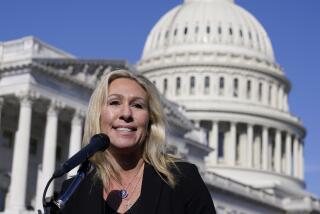Regulators Told of ‘Credit Crunch’ : Lending: Top federal banking officials hear borrowers complain about a lack of access to loans. Lenders say financially solid customers are rare.
Jack Goetz for five years had little trouble financing his Santa Monica company that prepares would-be lawyers for the bar exam. But last year, Goetz’s wealthiest investor sold his stake in the firm, and his bank cut off the company’s $600,000 credit line.
Even though the business remained sound, the bank told Goetz that lending to the company was now too risky. He went to another lender, who dangled a potential credit line in front of Goetz for more than two months before turning him down.
On Tuesday, Goetz brought his tale of frustration to an unusual forum in Los Angeles in which four of the nation’s top bank regulators received a close-up look at the “credit crunch.”
Prompted by complaints that tight lending is stifling economic recovery, Treasury Secretary Nicholas F. Brady called for the hearings, hosted by Office of Thrift Supervision Director Timothy Ryan, acting Comptroller of the Currency Stephen Steinbrink, Federal Reserve Board Gov. John P. LaWare and Federal Deposit Insurance Corp. Director C.C. Hope Jr.
Scheduling the meeting in the heat of the presidential election has prompted some suggestions that it was politically motivated. But Ryan, who moderated the meeting, denied it, noting that various credit crunch meetings have been held regularly over the last year and a half.
Despite numerous frustrations voiced by borrowers, the meetings showed there is little common ground between borrowers and lenders on whether a “crunch” even exists.
Borrowers such as Goetz, who has recently found new investors, repeatedly argued that the crunch is real, with credit nearly impossible to get from banks.
Real estate executives said that money for commercial and residential projects has dried up as never before, with lenders especially reluctant to refinance or restructure existing commercial real estate loans because the action would not be viewed favorably by either regulators or securities analysts.
“Our industry is walking around trying to figure out how to replace the industry that supplied the capital to build the housing in this state,” Sacramento builder William Mazza said.
Lenders argued that they have money to make loans, but lack financially solid customers who want to borrow in today’s uncertain economy.
Charles Bell, a Bank of America executive vice president and senior credit officer, said that many businesses that were good risks two years ago are not today because their fortunes have deteriorated in the soft economy. He added that most good customers aren’t borrowing because they want to shrink their debt and slash capital expenditures.
One common complaint is that lenders are cutting back because of burdensome federal rules, made worse by tough, time-consuming exams from regulators. Some panelists said that small businesses, especially those in low-income areas such as southern Los Angeles, are especially hurt because they depend more on bank loans for financing than large corporations.
A. Vincent Siciliano, chief executive of International Savings Bank in San Diego, said he and other thrift executives are distracted from lending because they spend up to one-third of the year just dealing with regulators. Richard L. Barkhurst, an executive vice president with First Interstate Bank of California, added that meeting federal requirements for commercial real estate appraisals translates to appraisals that run 250 pages long, cost $75,000 and can delay deals for five months.
The hearing included four panels representing commercial real estate developers, home builders, small businesses and lenders. One group especially vocal about being excluded was the Western Independent Bankers, which charged that being excluded from the hearing prevented independent banks from voicing their complaint that tough bank regulations are discouraging lending to small business.
More to Read
Inside the business of entertainment
The Wide Shot brings you news, analysis and insights on everything from streaming wars to production — and what it all means for the future.
You may occasionally receive promotional content from the Los Angeles Times.









